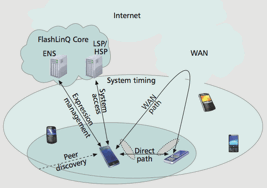Qualcomm Announcement of New OFDM Technology for Many Applications Including Wireless Mics

Qualcomm states,
FlashLinq advances a concept known as proximal communications, whereby users can continuously connect, disconnect and communicate directly with other mobile users at broadband speeds based on their physical proximity. The technology is designed to complement traditional cellular-based services and serve as a scalable platform for new types of applications.“By expanding the operator model of managed services to the frontier of proximal communications, Qualcomm continues to demonstrate its leadership in wireless technology and innovation” said Ed Knapp, senior vice president of business development and engineering for Qualcomm. “FlashLinq’s direct discovery and distributed communications allows operators to naturally extend their cellular networks. The technology can efficiently support new and enhanced services in areas such as direct local advertising, geo-social networking and machine-to-machine communications.”
While wireless mics are not a large market product, their presence in TV spectrum with their present technology severely limits new spectrum options for this “beachfront property”. It is not just that wideband FM is not spectrally efficient - the same reason it is being phased out for Part 90, but the present equipment is very susceptible to intermodulation interference - remember NEXTEL/public safety? - and the only way to avoid it is to scatter wireless mic channels across large swaths of spectrum - limiting its use. Just as a trace of oil can contaminate a large amount of drinking water, a few wireless mics with FM can deny huge amounts of spectrum to other users. Wireless mics need and deserve spectrum access, but not the present access which may be unique in major industrialized countries.
When analog NTSC was the TV technology, its quirks resulted in such low spectrum use that wireless mics were not a problem. But with today’s demand for spectrum, the low density use limitation of wireless FM is getting to be a major burden for those who covet the spectrum - be they the CTIA crowd (Qualcomm’s traditional customer base) or the Silicon Valley-based TWBD advocates.
Now that an alternative wireless mic technology has a major player behind it, we hope that FCC and people interested in UHF spectrum start pressing harder for an orderly phase out of wideband FM except for small users who need only a handful of audio channels, e.g. small churches, conference rooms, MCs at weddings, etc.



![Validate my RSS feed [Valid RSS]](valid-rss-rogers.png)

